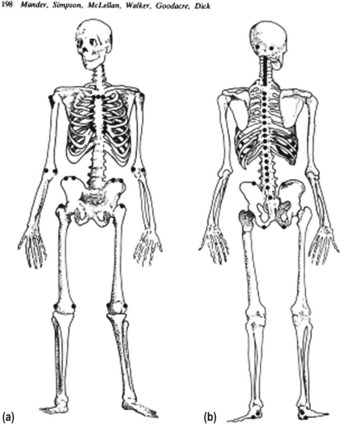Chapter 15 E-materials
Author profiles
Mark Clemence Mphil GradDipPhys MCSP
Mark Clemence is a specialist physiotherapist working at Torbay Hospital, Devon.
Appendix 15.2 Useful resources and addresses
Case Study 15.1
Background
• SC was a 56-year-old woman who was recently referred to her local NHS Rheumatology department.
• She works as a waitress and was worried because of increasing pain in her hands which had been getting worse over 12 months and was causing her difficulty gripping plates and trays.
• In addition to hand pain she was also experiencing pain in her neck, both shoulders and both first toes.
Initial management
• SC initially consulted her GP, but was seen by a locum, who undertook a rheumatoid factor blood test.
• The results for this were negative, therefore the locum GP advised her that her problems were due to ‘wear and tear’.
• She was prescribed non-steroidal anti-inflammatory (NSAID) medication.
• Because things were not improving she returned to see her own GP who made a referral to the local rheumatology department.
• During the time she was waiting for the appointment she experienced further deterioration in her symptoms with increasing stiffness and pain in her hands. This was becoming particularly bad in the mornings, making it difficult for her to dress, with reducing shoulder flexibility causing problems reaching above her head.
Rheumatology referral
• When she attended her local hospital for a clinic appointment the rheumatologist asked questions that established in detail the nature and behaviour of her symptoms, her family history and her general health.
• Physical examination found her to have a slightly flexed posture and slightly protruding chin, otherwise spinal alignment was normal.
• Bilateral thickening was present over the 2nd and 3rd metacarpophalangeal (MCP) joints, which were tender when squeezed.
• Hand movement was normal, but she displayed reduced grip power.
• Wrists and elbows were normal.
• Bilaterally her shoulder flexion, abduction and internal rotation was slightly reduced.
• Neck movements were symmetrically reduced by about 20% in all directions.
• Hip, knee and ankle joints were normal.
• There was bilateral hallux valgus and stiffness of both first metatarsophalangeal (MTP) joints.
• On the basis of the history and examination the rheumatologist diagnosed seronegative rheumatoid arthritis, also diagnosing osteoarthritis of the first MTPJs.
• The rheumatologist said that he thought that the cervical spine problems were most likely due to degenerative changes.
• He explained that the results of the rheumatoid factor test may have been negative, but the test should not have been carried out in isolation to exclude the diagnosis of rheumatoid.
• SC was clearly showing signs of synovitis in her MCPJs and shoulders and to confirm the diagnosis a blood test for broad-spectrum inflammatory markers was needed.
• This was done along with X-rays of the hands, shoulders and cervical spine, to look for joint erosions and confirm the diagnosis in the cervical spine.
• The X-rays showed cervical degeneration, no changes in the shoulder joints and one small joint erosion of her right 2nd MCPJ.
• Results of the broad-spectrum test showed raised inflammatory markers.
• SC was prescribed a limited and reducing course of steroids to provide immediate symptom relief, and was prescribed the drug methotrexate, which can take up to 12 weeks to achieve therapeutic effect.
• She was referred to the rheumatology team physiotherapist and occupational therapist based in the hospital.
• In addition she was referred to the podiatrist at her GP’s surgery for the foot pain.
Physiotherapy intervention
• The physiotherapist undertook an in-depth assessment of all main joint movements and in addition did a detailed assessment of the shoulders.
• The physiotherapist advised gentle range of movement exercises for the shoulders to maintain flexibility, advised the patient about posture correction and neck exercises.
• A follow-up appointment was given to check progress, exercises and provide additional advice.
• SC was reviewed again by the rheumatologist after 3 months and she was also seen again by the physiotherapist to review the progress made.
• There had been a significant improvement in the hands and shoulders, with SC finding it easier to dress and reported having fewer problems when carrying things at work.
• She remains on regular 6-monthly rheumatology clinic reviews and is also seen on an as-needs basis by the physiotherapist when she attends the hospital for these reviews.
Case Study 15.2
Current problem
• Stiffness, lasting most of the day, mainly affecting her thoracic spine.
• Some thoracic spine pain, but stiffness more of a problem.
• Understanding of disease and disease process was limited and based on patient’s own experience of symptoms.
• She has “got on with life” as she has had back symptoms for such a long time.
• Stiffness, when inactive, better when active.
• ES wakes approx 4:00 am with increased back stiffness and discomfort.
PMH
Stay updated, free articles. Join our Telegram channel

Full access? Get Clinical Tree









